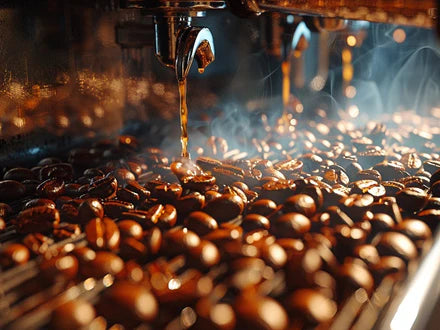Colombian coffee is renowned for its rich flavor and high quality, making it one of the most sought-after coffees in the world. With a history dating back to the 18th century, the coffee industry in Colombia has evolved to become a major player in the global market. In this article, we will delve into the world of Colombian coffee, exploring its uniqueness, history, production process, health benefits, and sustainability efforts.
A Brief Overview:
Colombian coffee is primarily grown and produced in the central and southern regions of the country, with the majority being Arabica beans. These beans are known for their smooth, rich, and well-balanced flavor, with a medium to full body. The high altitudes, fertile volcanic soil, and optimal climate in Colombia contribute to the exceptional quality and taste of its coffee.
The History of Colombian Coffee:
Coffee cultivation in Colombia began in the 18th century, with the first commercial crops being planted in the early 1800s. The coffee industry in Colombia has since then grown significantly, with production and exports reaching record highs in recent years.
Read: Coffee Origins 101: South America
The Different Regions of Colombian Coffee:
Colombian coffee is grown in several regions, each with its own unique characteristics and flavor profiles. Some of the best coffee is produced in the regions of Nariño, Huila, and Antioquia, known for their high altitudes and ideal microclimates.
The Process of Growing and Harvesting Colombian Coffee:
Coffee in Colombia is typically grown using traditional methods, with farmers handpicking the ripe cherries and sorting them manually. The beans are then processed using either the washed or natural method, depending on the desired flavor profile.
The Journey from Bean to Cup:
Colombian coffee beans are roasted and packaged in various ways, with some farmers still using traditional methods while others utilize modern technology. There are also various brewing methods for Colombian coffee, including drip brewing, French press, and espresso.
The Health Benefits of Colombian Coffee:
Aside from its delicious taste, Colombian coffee also offers numerous health benefits. It is rich in antioxidants and nutrients, and has been linked to improved brain function, increased metabolism, and reduced risk of certain diseases.
Sustainability and Social Impact of the Colombian Coffee Industry:
Efforts are being made in Colombia to promote sustainable and ethical coffee production, with a focus on environmental conservation and fair trade practices. The coffee industry also plays a significant role in the lives of Colombian farmers and their communities, providing employment opportunities and contributing to the country's economy.
Exploring the World of Colombian Coffee:
For those looking to experience the richness of Colombian coffee, there are plenty of options available. You can find and purchase the best Colombian coffee from local markets, specialty coffee shops, or online retailers. And for the ultimate Colombian coffee experience, try it in traditional ways such as a cafecito or tinto, or indulge in a specialty coffee drink like a cappuccino or latte.
Key Takeaways:
Colombian Coffee: A Brief Overview
Colombian coffee is well-known for its rich flavor, medium acidity, and well-balanced profile. It is cultivated in various regions, each producing beans with their own unique characteristics. The process of growing, harvesting, and roasting Colombian coffee has been perfected over centuries, making it one of the top-quality coffees in the world.
Fun Fact: Colombia is the third-largest producer of coffee in the world, with over 500,000 coffee farms spread throughout the country.
What Makes Colombian Coffee Unique?

Colombian coffee is renowned for its unique qualities, which can be attributed to its ideal growing conditions. These include high-altitude, rich volcanic soil, and a perfect balance of sunlight and rainfall. These factors all contribute to a rich, smooth flavor with a mild acidity and a well-balanced profile.
Moreover, the diverse microclimates found in Colombia result in a wide range of flavor profiles, ranging from fruity and floral to nutty and chocolatey. For a true taste of Colombia's coffee diversity, consider trying single-origin beans from different regions.
The History of Colombian Coffee
- Introduction of Coffee: The history of Colombian coffee began with the introduction of coffee plants by Jesuit priests in the mid-18th century.
- Expansion of Coffee Production: The commercial production of coffee expanded rapidly in the 19th century, driven by favorable climate and soil conditions.
- Impact of Coffee on Economy: Colombian coffee became a significant contributor to the country's economy, leading to the development of coffee-growing regions.
- Coffee Culture: The history of Colombian coffee is intertwined with the rich coffee culture, shaping Colombia's identity and global coffee appreciation.
How Did Coffee Cultivation Begin in Colombia?
- Introduction of Coffee: Coffee was first introduced to Colombia in the early 1800s by Jesuit priests who brought coffee plants.
- First Commercial Plantation: The first commercial coffee plantation was established in the northeast region by the Ortiz family.
- Growth and Expansion: Coffee cultivation began to rapidly expand, spreading to different regions of the country.
- Government Support: The Colombian government played a significant role in promoting and supporting the coffee industry.
In a remote Colombian village, a farmer named Juan discovered wild coffee plants. With dedication and the help of his community, he nurtured these plants, leading to the beginning of coffee cultivation in Colombia. This revival of coffee cultivation not only improved the livelihoods of the villagers but also had a significant impact on the country's economy.
How Has the Coffee Industry Evolved in Colombia?
- Introduction of Arabica coffee: In the 1800s, Colombia made a significant shift to growing Arabica coffee, revolutionizing its coffee industry.
- Establishment of the National Federation of Coffee Growers: Formed in 1927, this federation unified Colombian coffee production, setting standards and promoting growth.
- Development of Juan Valdez: In 1959, the fictional character of Juan Valdez was created to market and promote Colombian coffee globally, greatly boosting its recognition.
- Implementation of coffee regulations: In 1980, strict regulations were implemented in Colombia to maintain high-quality coffee, ensuring consistency and excellence in the industry's production.
The Different Regions of Colombian Coffee
The diverse flavor and characteristics of Colombian coffee can be attributed to the different regions it is grown in, each offering unique profiles based on their geographical attributes.

| Region | Flavor Profile | Characteristics |
| Huila | Chocolatey, Nutty | High acidity, medium body |
| Nariño | Bright, Fruity | Floral aroma, clean aftertaste |
| Caldas | Spicy, Herbal | Medium acidity, full body |
Which Regions Produce the Best Coffee in Colombia?
The regions of Antioquia, Santander, and Huila are known for producing the best coffee in Colombia. This is due to their diverse microclimates, elevations, and soil compositions, which result in beans with distinct flavor profiles. These range from fruity and bright to full-bodied and chocolatey, catering to a variety of taste preferences.
What Are the Flavor Profiles of Different Regions?
Flavor Profiles of Different Regions:
| Region | Flavor Profile |
|---|---|
| North | Nutty and fruity |
| Central | Balanced with caramel notes |
| Eastern | Bright and citrusy |
| South | Rich and chocolatey |
The Process of Growing and Harvesting Colombian Coffee
- Preparation: Clear the land and select the best altitude and climate for growing Colombian coffee.
- Planting: Sow the coffee seeds in nurseries to germinate for about 12 months.
- Transplanting: Transfer the coffee seedlings to the designated fields for further growth.
- Maintenance: Regularly prune, fertilize, and protect coffee plants from pests and diseases.
- Harvesting: Handpick only ripe coffee cherries, ensuring selective picking for the best quality beans.
- Processing: Remove the outer pulp and skin, ferment, wash, and dry the beans.
- Sorting: Grade the beans based on size, color, and overall quality.
What Techniques Are Used to Grow Coffee in Colombia?
In Colombia, coffee cultivation involves a variety of techniques to produce high-quality yields. One common method is shade-grown farming, which protects the coffee plants from harsh sunlight and promotes slower fruit maturation, resulting in richer flavors. Many farmers also practice organic farming, avoiding the use of synthetic pesticides and fertilizers. The terracing method is also frequently used, particularly in hilly areas, to prevent soil erosion and assist with irrigation. Additionally, selective picking of ripe cherries is crucial in maximizing the quality of the coffee beans.
How Is Coffee Harvested and Processed in Colombia?
- Harvesting: In Colombia, coffee is harvested mostly by hand, ensuring that only ripe cherries are picked to maintain the highest quality.
- Processing: The harvested cherries then go through the wet method, which includes pulping, fermentation, washing, and drying.
The Journey from Bean to Cup
- Harvesting: Ripe coffee cherries are handpicked from the plants.
- Processing: The outer pulp is removed, and the beans are dried.
- Exporting: The beans are shipped to various destinations worldwide.
- Roasting: The green coffee beans are roasted to perfection.
- Grinding: The roasted beans are ground to the desired consistency.
- Brewing: Hot water is passed through the ground coffee to extract the flavors.
- Serving: The brewed coffee is poured into a cup and enjoyed as part of the journey from bean to cup.
How Are Colombian Coffee Beans Roasted and Packaged?
- Roasting: Colombian coffee beans are expertly roasted to perfection, guaranteeing even heat distribution for the best possible flavor extraction.
- Packaging: After roasting, the beans are carefully packaged in airtight bags to maintain their freshness and flavor.
In the hills of Colombia, Maria, a dedicated coffee farmer, meticulously roasts her beans using traditional methods. She then personally packages them by hand, ensuring that the aroma and richness of Colombian coffee are preserved for coffee enthusiasts all around the world.
Read: Which Country Should You Buy Coffee Beans From
What Are the Different Brewing Methods for Colombian Coffee?

- Drip method: One of the different brewing methods for Colombian coffee is the drip method, where hot water is poured over ground coffee in a filter, allowing it to drip through into a carafe.
- French press: Another popular method is the French press, where ground coffee is mixed with hot water, the plunger is pressed down, and the coffee is poured.
- Espresso machine: For a concentrated coffee, an espresso machine can be used to force hot water through finely-ground coffee using high pressure.
- Aeropress: One unique method is using an Aeropress, a gadget that presses hot water through coffee to produce a rich and smooth coffee.
- Cold brew: For a refreshing option, cold brew involves steeping coffee grounds in cold water for an extended period to extract flavor.
The Health Benefits of Colombian Coffee
Colombian coffee provides numerous health benefits, such as being a rich source of antioxidants, potentially decreasing the risk of certain diseases, improving physical performance, and enhancing mental alertness. These advantages are due to its high levels of caffeine and antioxidants. When consumed in moderation, Colombian coffee can be incorporated into a healthy lifestyle. To fully reap its benefits, it is recommended to avoid excessive sugar and cream, and instead choose organic, shade-grown, and fair-trade varieties.
What Nutrients and Antioxidants Are Found in Colombian Coffee?
Colombian Coffee Nutrients and Antioxidants Table
What Nutrients and Antioxidants Are Found in Colombian Coffee?How Does Colombian Coffee Affect the Body and Mind?
- Increased alertness: Colombian coffee contains caffeine, which stimulates the central nervous system, enhancing alertness and reducing fatigue.
- Mood enhancement: The caffeine in Colombian coffee can improve mood, decrease the risk of depression, and enhance cognitive function.
- Physical performance: Caffeine can improve physical performance by mobilizing fatty acids from the fat tissues, making them available for energy.
If you're wondering how Colombian coffee affects the body and mind, look no further. With its caffeine content, it can provide increased alertness and improved mood, while also enhancing cognitive function. However, it's important to consume in moderation to avoid potential side effects such as anxiety and sleep disturbances.
Sustainability and Social Impact of the Colombian Coffee Industry

As coffee lovers, we often focus on the taste and quality of the beans we consume. However, it is also important to consider the sustainability and social impact of the coffee industry. In this section, we will delve into the efforts being made in Colombia to promote sustainability and support the local communities involved in the production of this beloved beverage. From environmental initiatives to fair trade practices, we will explore the various ways in which the Colombian coffee industry is striving for a positive impact.
What Efforts Are
Efforts in the Colombian coffee industry center around sustainability, fair trade, and social responsibility. Many farms prioritize eco-friendly practices, such as organic cultivation and water conservation. Additionally, various initiatives aim to improve the livelihoods of coffee farmers, ensuring fair wages and safe working conditions. Collaborative projects with local communities also contribute to the industry's positive social impact.
Read: The Social Impact of Coffee How Your Cup Can Make a Difference
Pro-tip: When purchasing Colombian coffee, look for certifications like Fair Trade and Rainforest Alliance to support sustainable and ethical practices.


